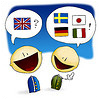
Session Overview
 |
Language is an amazing thing. How do we learn and use language in our everyday lives? How does the brain make this happen? This session explores the brain basis of language perception and comprehension, how language contributes to our understanding of our environment, and how we learn languages. Keywords: phoneme, speech, comprehension, hearing, writing, reading, phonology, syntax, evoked response potential (ERP), meaning, pragmatics, aphasia, language acquisition Image courtesy of zinjixmaggir on Flickr (aka Markus Koljonen, http://iki.fi/markus.koljonen). |
Session Activities
Readings
Read the following before watching the lecture video.
- [Sacks] Chapter 9, "The President's Speech" (pp. 80-86)
- One of the following textbook chapters:
Lecture Videos
View Full Video
- Lecture 12: Language (00:53:17)
View by Chapter
- Language Basics: Sounds We Hear and Distinguish (00:17:16)
Language Basics: Sounds We Hear and Distinguish
> Download from iTunes U (MP4 - 115MB)
> Download from Internet Archive (MP4 - 115MB)
- From Sound to Meaning: Syntax, Semantics, and Comprehension (00:08:36)
From Sound to Meaning: Syntax, Semantics, and Comprehension
> Download from iTunes U (MP4 - 115MB)
> Download from Internet Archive (MP4 - 115MB)
- Problems with Language: Aphasia and the Neural Basis of Speech (00:15:16)
Problems with Language: Aphasia and the Neural Basis of Speech
> Download from iTunes U (MP4 - 115MB)
> Download from Internet Archive (MP4 - 115MB)
- Language Acquisition: Infants, Bilingualism, and the Case of Genie (00:12:07)
Language Acquisition: Infants, Bilingualism, and the Case of Genie
> Download from iTunes U (MP4 - 115MB)
> Download from Internet Archive (MP4 - 115MB)
Video Resources
Discussion
Language is just incredible – think about how easy it is for us, as babies, to learn our native language effortlessly, and yet how hard it is, once we’ve already learned a language, to learn another… Read more »
Check Yourself
Short Answer Questions
1) Language is a system of communication and representation that is governed by systematic rules. The rules of can be studied at multiple levels. For each of the following terms, identify the features of language they describe:
- Syntax
- Semantics
- Phonology
› View/Hide Answers
- Syntax: The description of how words are organized into phrases and sentences. Often called the "grammar" of a language.
- Semantics: The description of the meaning of words, phrases, and sentences.
- Phonology: The description of the sounds of a language and how they are put together to make words.
2) Language is a powerful system because of the principle of discrete infinity, which means that a small number of basic units can be combined in an unlimited number of ways to represent and communicate ideas.
- What is the smallest unit of meaning in language called? Give an example of how these can be combined.
- What is the smallest contrastive unit of sound in language called? Give an example of one of these from English. Give an example of one of these from a foreign language you might have heard, but which is not present in English.
› View/Hide Answers
- Morpheme. For example: Un + believe + able = unbelievable
- Phoneme. For example: /k/ as in "cat" in English. In other languages but not English, e.g., the trilled "r" in Spanish, the clicks in Bantu, the trilled "r" in French, the hard "h" in Hebrew.
3) It is remarkable that babies learn language so fast and so effectively, even though no one ever explicitly teaches them the rules of their language. Describe two facts you have learned about how babies learn language.
› Sample Answers
- Girls learn more words earlier than boys.
- Babies begin to lose the ability to discriminate foreign language speech sounds by 9-12 months.
- Children might use words wrong in overextensions (e.g. calling all animals "doggie") or underextensions (refusing to call any other dog besides the family pet a "doggie").
Further Study
These optional resources are provided for students that wish to explore this topic more fully.
| TYPE | CONTENT | CONTEXT |
|---|---|---|
| Supplemental reading | Crystal, D. How Language Works: How Babies Babble, Words Change Meaning, and Languages Live Or Die. Penguin, 2007. ISBN: 9781583332917. [Preview with Google Books] | An introduction to lingustics written for the layperson, recommended by the TAs. |
| Blog | Language Log | Covers language in current events, run by University of Pennsylvania phonetician Mark Liberman with multiple guest linguists |
| Web resource | Lewis, M. Paul (editor). Ethnologue: Languages of the World. Sixteenth edition. SIL International, 2009. | Reference work on languages of the world, with web resources and preview pages of print edition |
| Wikipedia | Genie (feral child) | Example discussed at end of class. |
| Textbook supplement | Study materials for Ch. 8 "Language and Thinking: What Humans Do Best." In Kosslyn & Rosenberg, Psychology in Context, 3/e (Pearson, 2007) | Practice test questions, flashcards, and media for a related textbook |
